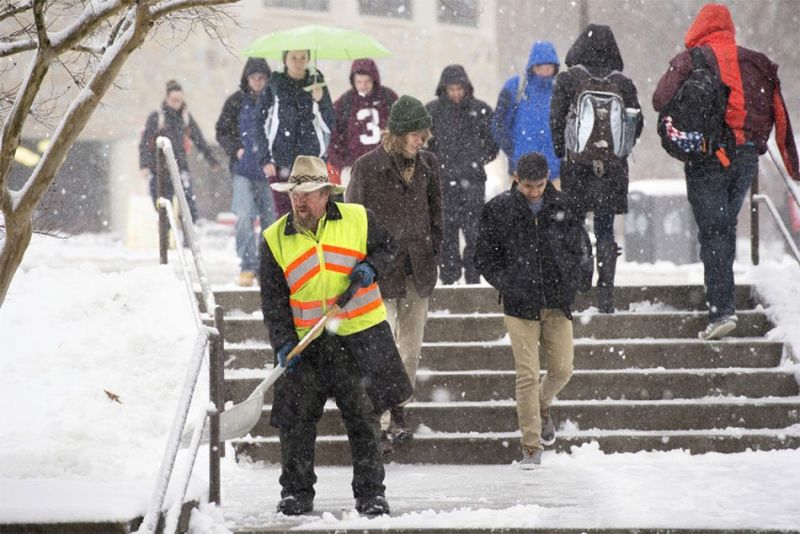
Winter weather in Virginia offers biting cold temperatures and blustery wind. Above all else, it is unpredictable. And that presents a real problem for the Virginia Tech teams tasked with making the tough calls around the university operating status. One word can describe the decision-making process: complex.
Here’s how Virginia Tech goes about preparing the campus and its various locations for the winter weather and what happens during a storm and after the storm has passed.
- A stakeholder meeting begins preparations. In October, stakeholders from across the university and the Town of Blacksburg meet to review the university’s closing policy, to update that policy and to discuss lessons learned from the previous winter. A separate problem entirely but central to the conversation is how Virginia Tech will communicate its winter weather response effectively across all university locations in the commonwealth.
The stakeholders meeting is a big one, including personnel from the Virginia Tech Police Department, emergency management, the facilities department, parking and transportation, human resources, the Office of the Executive Vice President and Provost, student affairs, university relations, the Town of Blacksburg and Blacksburg Transit.
- The forecast is carefully monitored. As the potential for a storm increases, university officials start watching forecast models and communicating with the National Weather Service to monitor weather across all Virginia Tech locations. This information is shared among university leadership and units across the university. Since civen conditions will vary across the state, university staff work carefully to monitor the needs and conditions of each university location.
The Virginia Tech community can monitor the latest weather conditions via the weather resources shared on the university status page for locations across Virginia. Among these resources is WeatherSTEM, Virginia Tech’s very own weather monitoring technology that provides current weather conditions and updates, along with live on-campus cameras.
- An emergency snow route notice may be declared on the Blacksburg campus. Depending on the forecast, an emergency snow route notice may be declared before the storm hits. This means certain roads on campus must remain open for emergency vehicle use and plows. All vehicles parked along these roads must be removed or risk being towed.
- The call must be made for overnight storms. By approximately 5 a.m. the morning of a storm, Senior Vice President and Chief Business Officer Dwayne Pinkney collects road-condition and readiness reports from the Virginia Tech Police Department, facilities and other university. Based on this information, the decision is made as to whether the campus opens, operates on a delay, or is closed. The senior vice president and chief business officer then confers with the provost and alerts university relations leadership and the Virginia Tech Police shift commander of the decision.
For Roanoke, Northern Virginia, Richmond and other university locations, local police, along with university emergency management leaders, university relations and other partners work with representatives from these locations around their operational status. Working collaboratively, decisions are made on a case-by-case basis for all Virginia Tech locations.
Decisions concerning the Blacksburg campus status depend largely in part whether Blacksburg Transit (BT) can operate safely. BT runs 50 buses that serve 13 routes in Blacksburg and Christiansburg. The Virginia Tech community makes up approximately 95 percent of ridership.
- University relations notifies the campus community through the University Status page, VT News email, social media and the weather/emergency hotline (540-231-6668). Virginia Tech Emergency Management will also notify the campus community through the VT Alerts system.
During the storm, the university community is asked to frequently monitor the university status page for the latest updates impacting all Virginia Tech locations. The university community is also encouraged to download the LiveSafe app to have fast access to pertinent emergency information and to report emergencies. Those who do not have access to the internet may call the weatherline at 540-231-6668.
- Once winter weather starts, grounds workers plow roads, loading docks and service all drive in 12-hour shifts. Sidewalks, stairs, parking lots and streets are treated when possible before and during the storm with a 23 percent salt brine solution obtained from the tanks at the on-campus Power Plant.
According to Anthony Watson, director of buildings and grounds, it’s truly a team effort. “We deploy over a dozen utility task vehicles, tractors and skid steers to help clear main sidewalks. More than 300 trade shop employees, housekeepers and even student workers come together to pitch in with shoveling,” said Watson.
- Some essential student services must still be maintained. Even if the campus is closed for the day or on a delayed opening, residential students still need essential services. This is when dining services kicks into high-gear to deploy teams to meet on-campus needs. To keep students and employees safe, dining centers are strategically selected to operate when inclement weather occurs. Students can check dining.vt.edu/hours for any updates on dining center hours.
If the university is closed due to inclement weather, Schiffert Health Center will open from 10 a.m. to 3 p.m. for urgent care only. If there is a delay, Schiffert will operate on a delay. If the campus is closed, Squires Student Center will maintain an operating schedule of 9 a.m. to 6 p.m. depending on weather and road conditions.
- What happens when the storm is over. Once the storm is over, teams work tirelessly to widen paths on sidewalks and roads. Contract crews clear parking lots (Virginia Tech teams try to keep parking lot drive lanes plowed during the storm.). Assigned team members report early, sometimes for days at a time, after a storm to treat any melt that has refrozen.

